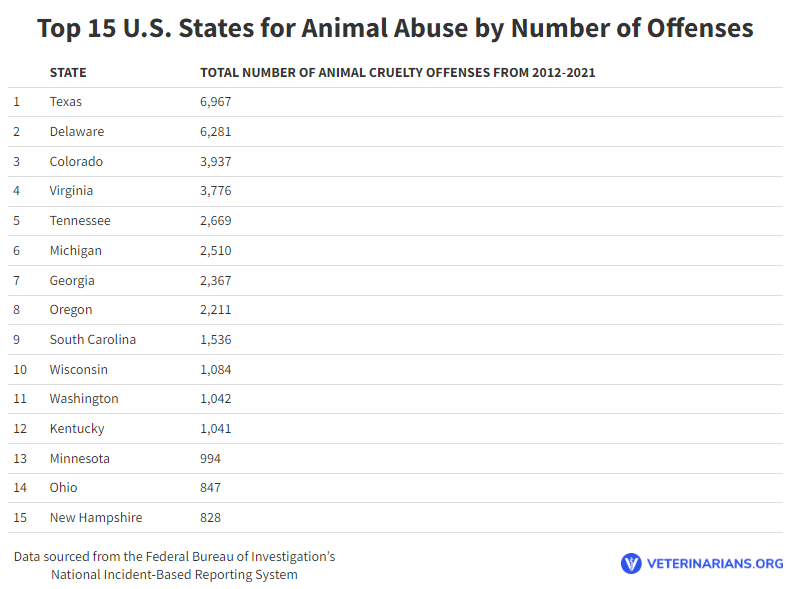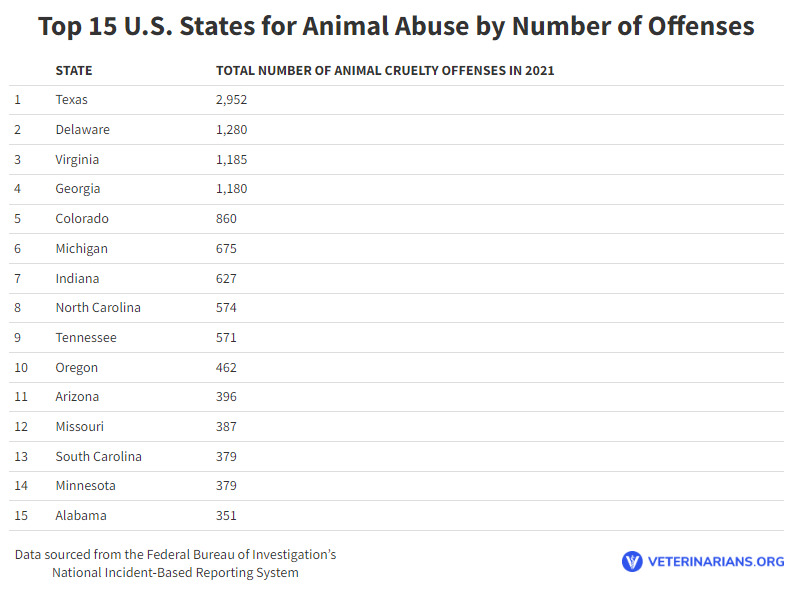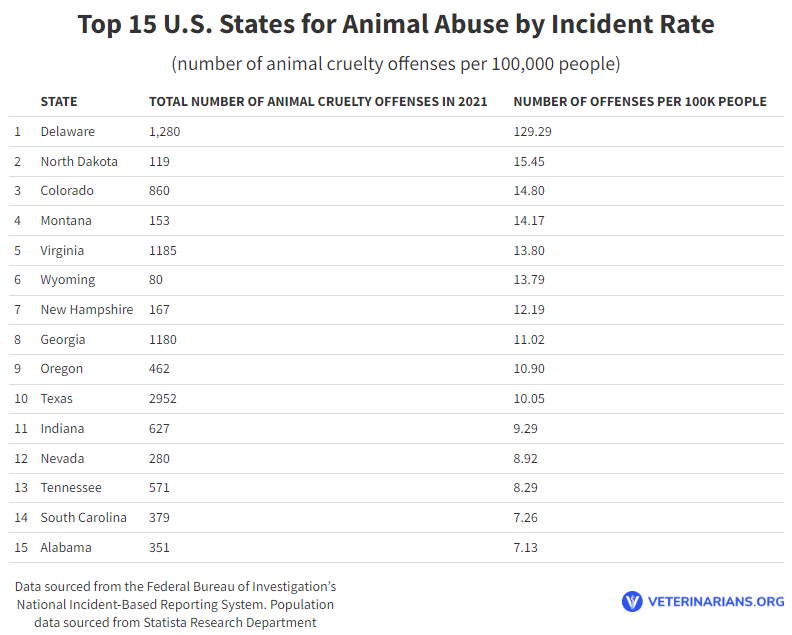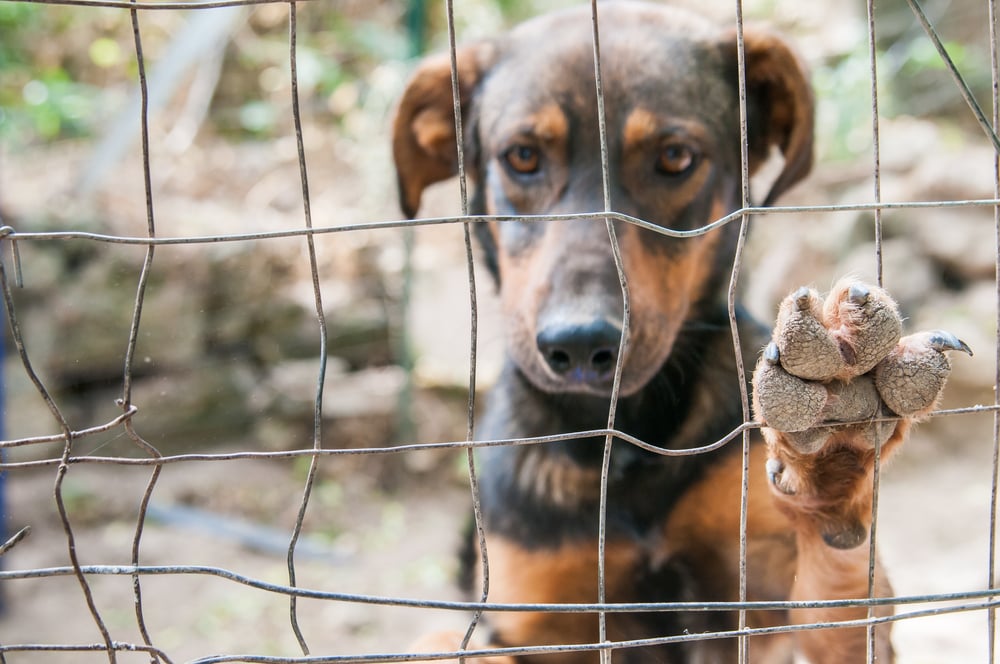Animal Abuse Statistics: State Rankings and Nationwide Data

Table of Contents
It’s estimated that every year, 10 million animals die from abuse in just the United States alone.
To learn where in the U.S. animal abuse is most prevalent, the Special Reports team at Veterinarians.org analyzed data from the Federal Bureau of Investigation’s National Incident-Based Reporting System (NIBRS)+, which provides national and state data for a variety of crime types, including animal cruelty offenses.
Using this data, the Special Reports team created three lists:
- The Top 15 states with the highest number of animal cruelty offenses over a 10-year period
- The Top 15 states with the highest number of animal cruelty offenses in 2021 (the most current year available)
- The Top 15 states with the highest incident rate of animal cruelty offenses in 2021 (number of offenses per 100K people).
Following the state data, interested parties can also find a list of general animal abuse statistics, including data around the demographics of animal abusers as well as the prevalence of animal abuse in domestic violence and child neglect situations.
Animal Abuse State Rankings

Our first list is an analysis of animal cruelty offenses in the U.S. over a ten year period (2012-2021). Texas takes the lead with nearly 7,000 animal cruelty offenses during this time period. This number is six times higher than the national average (1,146) and accounts for 15% of all animal cruelty offenses reported in the U.S. between 2012 and 2021.
Delaware, Colorado, Virginia, and Tennessee round out the Top 5. All of these states see offense numbers that are more than double the national average during the analyzed time period. Together, the number of animal cruelty offenses in these five states account for more than half of the nationwide total between 2012 and 2021.

There were 16,573 animal cruelty offenses reported to U.S. law enforcement agencies in 2021. Texas tops the list for the highest number of animal cruelty offenses in the nation. With 2,952 animal cruelty offenses reported in 2021, this number accounts for 17% of all nationwide offenses and is more than double the amount of offenses for the next leading state on the list.
Texas, along with Delaware, Virginia, and Georgia, are the only states on the list where animal cruelty offenses exceeded 1,000 within the analyzed year. All of the states listed see offense numbers that are higher than the national average (324).

Delaware has a significant lead in terms of the incident rate of animal cruelty offenses (the number of offenses per 100,000 people). The state sees 129 animal cruelty offenses for every 100,000 people. This incident rate is 16 times higher than the national average (8).
North Dakota, Colorado, Montana, and Virginia round out the Top 5 in this list. All but two of the states on the list have an incident rate that’s higher than the national average.

Animal Abuse Statistics
Every year, more than 10 million animals die from abuse in the U.S.
(Petpedia)
Animal Abuse Demographics
A 2009 study of 43,093 interviews found that “men, African-Americans, Native-Americans/Asians, native-born Americans, persons with lower levels of income and education, and adults living in the western region of the U.S. reported comparatively high levels of cruelty to animals, whereas Hispanics reported comparatively low levels of such behavior.”
(National Center for Biotechnology Information)
The study also found associations between animal cruelty and assessed antisocial behaviors, lifetime alcohol use disorders, conduct disorder, antisocial, obsessive-compulsive, and histrionic personality disorders, pathological gambling, and family history of antisocial behavior.
(National Center for Biotechnology Information)
In children, animal cruelty is more common in boys and children with antisocial personality traits.
(ResearchGate)
Among adults charged with animal cruelty, men vastly outnumber women 4 to 1 across most types of abuse.
(ResearchGate)
A survey of 261 inmates revealed that animal abuse in rural areas was more frequently targeted towards cats, while animal abuse in urban areas tended towards dogs, cats, and wild animals.
(Sage Journals)
A study of school massacre perpetrators found that 43% of perpetrators were reported to have committed acts of animal cruelty.
“This study investigates the quantity and quality of cruelty present in a sample of 23 perpetrators of school massacres from 1988 to 2012. Findings indicate that 43% of the perpetrators commit animal cruelty before schoolyard massacres and that the cruelty is usually directed against anthropomorphized species (dogs and cats) in an up-close manner.”
(ResearchGate)
Animal Abuse and Domestic Violence
Almost three quarters of participants in a survey of abused women reported abuse towards their animals as well.
“Thirty-eight women seeking shelter at a safe house for battered partners voluntarily completed surveys about pet ownership and violence to pets of the women reporting current or past pet ownership; 71% reported that their partner had threatened and/or actually hurt or killed one or more of their pets.”
(Taylor & Francis Online)
A dozen studies reported that between 15 and 48 percent of battered women delay leaving abusive situations—or return to them—because they fear for the safety of their pets.
(Tufts Now)
Women residing at domestic violence shelters were nearly 11 times more likely to report that their partner had hurt or killed pets than a comparison group of women who said they had not experienced intimate violence.
(Safe Pet Ottawa)
Among U.S. pet-owning families, 88 percent of homes with substantiated child abuse and neglect also include abuse toward animals.
(National Center for Biotechnology Information)
Animal Hoarding
It is likely that up to a quarter million animals – 250,000 per year – are victims of hoarders.
(Animal Legal Defense Fund)
In a study on animal hoarding, over three quarters (83%) of cases involved women.
“Residential home interiors were usually unsanitary, 93%; 70% had fire hazards; and 16% of residences involved in animal hoarding were subsequently condemned as unfit for human habitation. In 25% of the cases, the hoarder was placed under permanent or temporary protective care.”
(National Center for Biotechnology Information)
Animal hoarding has a rate of relapse of over 50%.
“Simply removing the animals from the residence may not solve the problem; the person still has the ability and perhaps the need to find more animals as the rate of relapse is at least 50%.”
(National Center for Biotechnology Information)
Racing Dogs
To ensure a constant supply of new racers, more than 25,000 dogs are bred each year in the United States. Some unwanted greyhounds are rescued by adoption organizations, but there are simply not enough homes for them all. At least 5,000 former racing greyhounds are killed each year.
(Animal Rights Foundation of Florida)
“Many racing dogs suffer injuries while racing; according to state records, at one point, a racing greyhound died every three days on a Florida track.”
(The Humane Society of the United States)
Over the past decade, there have been 438 greyhound drug positives at Florida tracks, including 73 greyhound cocaine positives.
“Other drug positives include novocaine, lidocaine, industrial solvent DMSO, and opiates oxycodone and oxymorphone.”
(The Humane Society of the United States)
Female greyhounds are routinely given an anabolic steroid to prevent a loss of race days. In 2017 legislative testimony, the Florida Greyhound Association estimated that 50 percent of female dogs are given this drug.
(The Humane Society of the United States)
Exotics and Zoo Animals
A study published by the U.K.’s Royal Society of Biology found that at least 75 percent of pet snakes, lizards, tortoises, and turtles die within one year in a human home—and it’s believed that most of these newly acquired animals die from stress related to captivity.
(People for the Ethical Treatment of Animals)
How many times smaller the average zoo enclosure is compared with an animal’s natural roaming range:
Polar bear: 1,000,000
Meerkat: 333,000
Cheetah: 63,000
Black bear: 25,000
Lynx: 21,000
Tiger: 18,000
Lion: 17,000
Brown bear: 300
(The Guardian)
Animal Activism
About 75% of animal rights activists are women.
“Virtually all studies of the animal rights movement have noted that women outnumber men among rank and file activists. Munro (2001) reported that about half of the animal protection organizations he studied were led by women. Herzog (1999) found that in the United States, gender parity varied with the goals of the organization. Groups having an animal rights focus were more likely to have women in prominent leadership positions than organizations with an animal welfare or animal shelter orientation.”
(ResearchGate)
+(The following states did not participate in NIBRS data collection in 2012: Wyoming, North Carolina, New York, New Mexico, New Jersey, Nevada, Maryland, Indiana, Hawaii, Florida, California, Alaska.)














